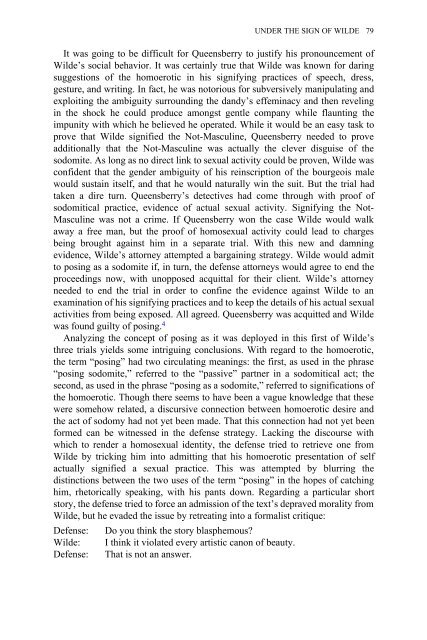Edited by Moe Meyer - Get a Free Blog
Edited by Moe Meyer - Get a Free Blog
Edited by Moe Meyer - Get a Free Blog
Create successful ePaper yourself
Turn your PDF publications into a flip-book with our unique Google optimized e-Paper software.
It was going to be difficult for Queensberry to justify his pronouncement of<br />
Wilde’s social behavior. It was certainly true that Wilde was known for daring<br />
suggestions of the homoerotic in his signifying practices of speech, dress,<br />
gesture, and writing. In fact, he was notorious for subversively manipulating and<br />
exploiting the ambiguity surrounding the dandy’s effeminacy and then reveling<br />
in the shock he could produce amongst gentle company while flaunting the<br />
impunity with which he believed he operated. While it would be an easy task to<br />
prove that Wilde signified the Not-Masculine, Queensberry needed to prove<br />
additionally that the Not-Masculine was actually the clever disguise of the<br />
sodomite. As long as no direct link to sexual activity could be proven, Wilde was<br />
confident that the gender ambiguity of his reinscription of the bourgeois male<br />
would sustain itself, and that he would naturally win the suit. But the trial had<br />
taken a dire turn. Queensberry’s detectives had come through with proof of<br />
sodomitical practice, evidence of actual sexual activity. Signifying the Not-<br />
Masculine was not a crime. If Queensberry won the case Wilde would walk<br />
away a free man, but the proof of homosexual activity could lead to charges<br />
being brought against him in a separate trial. With this new and damning<br />
evidence, Wilde’s attorney attempted a bargaining strategy. Wilde would admit<br />
to posing as a sodomite if, in turn, the defense attorneys would agree to end the<br />
proceedings now, with unopposed acquittal for their client. Wilde’s attorney<br />
needed to end the trial in order to confine the evidence against Wilde to an<br />
examination of his signifying practices and to keep the details of his actual sexual<br />
activities from being exposed. All agreed. Queensberry was acquitted and Wilde<br />
was found guilty of posing. 4<br />
Analyzing the concept of posing as it was deployed in this first of Wilde’s<br />
three trials yields some intriguing conclusions. With regard to the homoerotic,<br />
the term “posing” had two circulating meanings: the first, as used in the phrase<br />
“posing sodomite,” referred to the “passive” partner in a sodomitical act; the<br />
second, as used in the phrase “posing as a sodomite,” referred to significations of<br />
the homoerotic. Though there seems to have been a vague knowledge that these<br />
were somehow related, a discursive connection between homoerotic desire and<br />
the act of sodomy had not yet been made. That this connection had not yet been<br />
formed can be witnessed in the defense strategy. Lacking the discourse with<br />
which to render a homosexual identity, the defense tried to retrieve one from<br />
Wilde <strong>by</strong> tricking him into admitting that his homoerotic presentation of self<br />
actually signified a sexual practice. This was attempted <strong>by</strong> blurring the<br />
distinctions between the two uses of the term “posing” in the hopes of catching<br />
him, rhetorically speaking, with his pants down. Regarding a particular short<br />
story, the defense tried to force an admission of the text’s depraved morality from<br />
Wilde, but he evaded the issue <strong>by</strong> retreating into a formalist critique:<br />
Defense: Do you think the story blasphemous?<br />
Wilde: I think it violated every artistic canon of beauty.<br />
Defense: That is not an answer.<br />
UNDER THE SIGN OF WILDE 79


